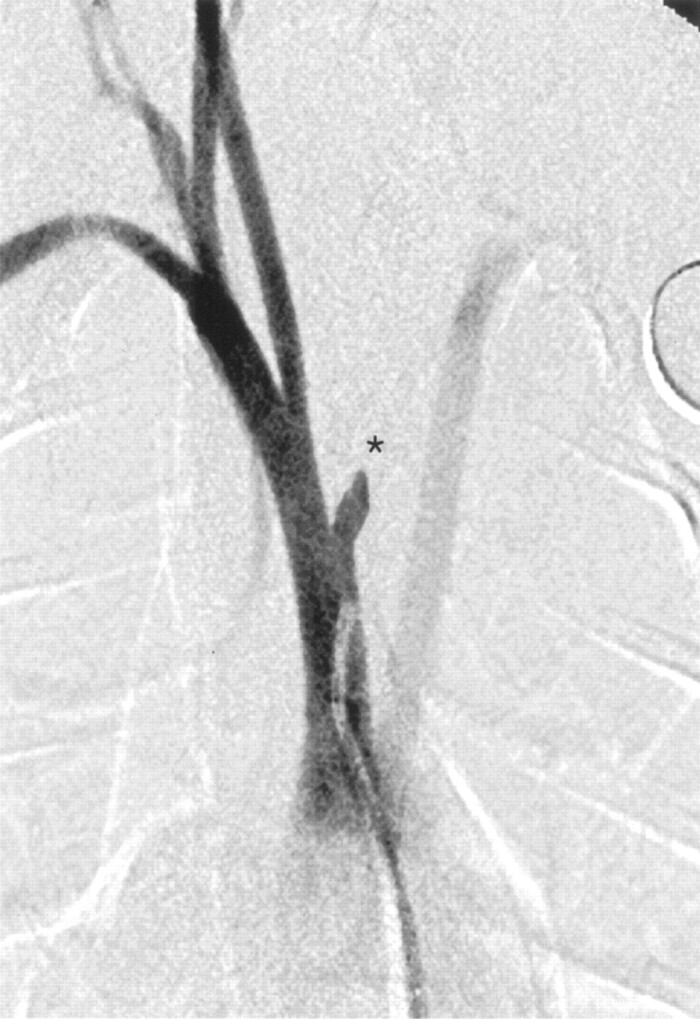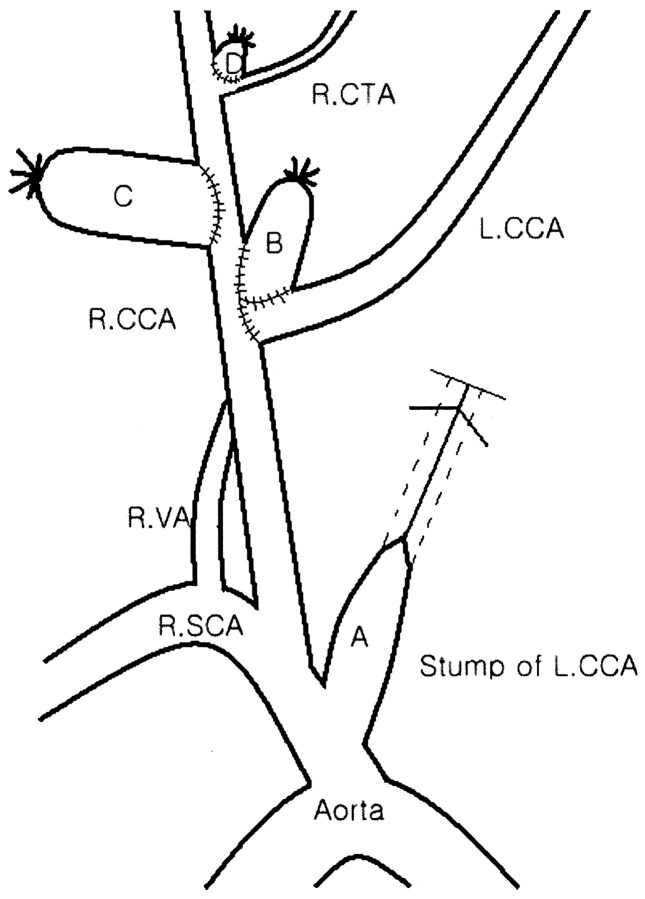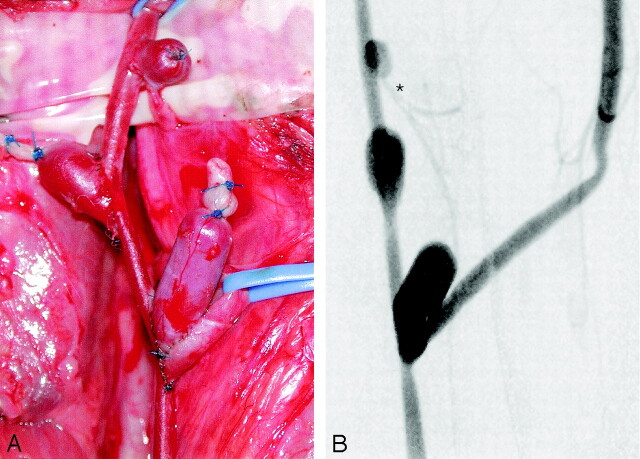Abstract
Summary: We developed an experimental canine model in which four types of aneurysm—bifurcation, side-wall, small branch-artery, and arterial-stump—were surgically created in the same animal. These experimental aneurysms are exposed to simultaneous but different hemodynamic stresses correlating to human intracranial aneurysms in different locations. Because this model allowed for the creation of four aneurysms, each with different hemodynamic features, it seems to offer advantages from ones previously described. This model may foster investigation of new and current endovascular devices.
Improved experimental animal models are needed to evaluate the safety and efficacy of current and new endovascular devices to treat intracranial aneurysms. Experimental aneurysms have been created to simulate various aspects of human intracranial aneurysms (1–5). The use of rabbit experimental aneurysms is gaining popularity because of its relatively low cost and the similarity in the sizes of the common carotid artery (CCA) of the rabbit and the human proximal middle cerebral artery (6–8). However, the rabbit model has limitations, such as the ability to create only one aneurysm per animal, the high procedure-related mortality rate, and inadvertent occlusion of the parent artery (4, 8). Compared with rabbit models, canine aneurysms are physiologically more similar to human aneurysms, more suitable for long-term experiments, and more appropriate for evaluating human-sized devices (2, 4, 5, 9, 10). However, conducting aneurysm experiments in dogs is expensive.
We developed an experimental model in which four aneurysms—bifurcation, side-wall, small branch-artery, and arterial-stump—were created in a single dog in one operation. This canine model can be used as a less-expensive alternative to other models for various animal research and teaching purposes.
Technique
Mongrel dogs weighing 16–20 kg were fed standard laboratory diets before a 12-hour fast before surgery. Anesthesia was induced with thiopentol 15–20 mg/kg and followed by endotracheal intubation. Anesthesia was maintained with isoflurane 1%–3% given through the endotracheal tube. The animals’ necks and groins were prepared and draped in the usual sterile fashion. During surgery, the animals’ heart rate, blood pressure, O2 saturation, ECG, and depth of anesthesia were monitored. We describe the surgical procedure in the order in which the aneurysms were created. All animal experiments were conducted in accordance with policies set by the Institutional Animal Care and Use Committee of St. Luke’s/Roosevelt Hospital Center Animal Care Facility. Institutional approval for the animal study was required and obtained.
Arterial-Stump Aneurysm
A 10-cm midline incision was made in the neck skin. The right external jugular vein and/or one of its tributaries (anterior or posterior facial vein) were isolated, and all side branches were ligated. A 5-cm venous segment was excised by using double-ligation technique and placed in saline solution containing heparin. Intraluminal blood in the harvested vein was thoroughly irrigated with heparinized saline. The venous segment was divided to construct two or three venous pouches. Both CCAs were then exposed. The left CCA was twice ligated as proximally as possible, and a temporary vascular clamp was placed just distal to the ligation. The artery was then divided between the vascular clamp and ligation site. The stump of the left CCA was sewn to create an aneurysmal pouch (Figs 1 and 2). A short segment of the left CCA could have been harvested at this time, if an arterial pouch were needed for later aneurysm creation with an arterial wall.
Fig 1.
Schematic of the four aneurysms surgically created in one dog. A indicates arterial-stump aneurysm; B, bifurcation aneurysm; C, side-wall aneurysm; and D, small branch-artery aneurysm. CTA indicates cranial thyroid artery; SCA, subclavian artery; and VA, vertebral artery.
Fig 2.

Digital subtraction angiogram shows the innominate artery. Left CCA is ligated proximally and divided just above the proximal ligature. Stump of the left CCA is shown as an aneurysmal pouch (asterisk).
Bifurcation Aneurysm
The distal segment of the divided left CCA was swung to the right through a tunnel made behind the trachea. The right CCA was temporarily closed with temporary clips, and an elliptical arteriotomy was performed. A partial end-to-side anastomosis of the left CCA to the proximal arteriotomy of the right CCA was created by using interrupted monofilament 6–0 Prolene sutures. One corner of the proximal end of the left CCA was incised at a variable angle to create the desired size of the aneurysmal neck. The venous segment from the external jugular vein or a small arterial pouch taken from the left CCA (V-shaped end) was then sutured to the notch formed by the anastomosis of both CCAs. After the anastomosis was completed, any captured thrombi were removed through the open-end of the grafted pouch. The open-end of the grafted vein segment/ arterial pouch was ligated with 4–0 Prolene sutures to create the bifurcation aneurysm (Figs 1 and 3).
Fig 3.
Bifurcation aneurysm is created by using a venous pouch of external jugular vein after a partial end-to-side anastomosis of the left CCA to the proximal part of the arteriotomy of the right CCA. Side-wall aneurysm is created by using a venous pouch of the external jugular vein with slight oblique orientation, and a small branch-artery aneurysm is created by using a venous pouch of the anterior facial vein at the junction of the CCA and cranial thyroid artery (asterisk).
A, Intraoperative view.
B, Digital subtraction image.
Side-Wall Aneurysm
After the bifurcation aneurysm was completed, the distal portion of the right CCA was again temporarily closed with temporary clips, and an elliptical arteriotomy was created on the lateral end of the right CCA. The size of the aperture was varied according to the desired aneurysm size. The venous segment from the external jugular vein or a small arterial pouch taken from the left CCA was then sutured to the arteriotomy site. The end of the grafted aneurysm sac was cut obliquely to decrease risk of possible spontaneous thrombosis of the aneurysm (Figs 1 and 3).
Small Branch-Artery Aneurysm
The cranial thyroidal artery is a small branch at the distal portion of CCA (11). After the right CCA and cranial thyroid artery were temporarily clipped, a 3–4-mm elliptical incision was made from the CCA in conjunction with the origin of the cranial thyroid artery. A small venous pouch (anterior or posterior facial vein) or arterial pouch was then fitted into the arteriotomy site (Figs 1 and 3). Table 1 summarizes the characteristics of the four experimental aneurysms.
TABLE 1:
Characteristics of the four aneurysms created in one dog
| Aneurysm | Operation Method | Pouch | Diameter (mm) | Aneurysm Simulateda |
|---|---|---|---|---|
| Arterial-stump | Division of L CCA, far proximal | CCA stump (artery) | ≤10 to 10–25 | Any sidewall or terminal-artery aneurysm |
| Bifurcation | Side-to-end anastomosis CCA to ipsilateral CCA, plus aneurysmal pouch | Vein/artery | ≤10 to 10–25 | Basilar apex, MCA bifurcation, terminal ICA, other |
| Side-wall | CCA plus aneurysmal pouch | Vein/artery | ≤10 to 10–25 | ICA aneurysm (eg, paraopthalmic), supraclinoid segment |
| Side branch-artery | CCA, cranial thyroidal branch; junction plus aneurysm pouch | Facial vein or artery | ≤10 | SCA, AICA, PICA aneurysm, other small aneurysm |
AICA indicates anterior inferior cerebellar artery; ICA, internal carotid artery; MCA, middle cerebral artery; PICA, posterior inferior cerebellar artery; and SCA, superior cerebellar artery.
Discussion
An improved in vivo animal model of human intracranial aneurysms is needed, particularly for academic and industrial evaluations of the feasibility, safety, and efficacy of current and new endovascular devices. A robust experimental model should include the following features: 1) good-quality aneurysms that offer stability and longevity without spontaneous thrombosis; 2) aneurysmal homogeneity with hemodynamics, coagulation profiles, and tissue responses similar to those of human intracranial aneurysms; 3) ease in animal handling and surgical technique; 4) cost-effectiveness; 5) aneurysms that can be treated as human intracranial aneurysms are; and 6) reproducibility to permit the comparison of devices.
As a laboratory animal, the dog has many of these features, including ease of handling, large vessels for simple surgical technique, and excellent long-term survival (2, 4, 5, 9, 10). However, these animals are expensive, especially when used in large experiments. Therefore, attempts have been made to create multiple aneurysms in a single animal. For example, bilateral side-wall aneurysms and a combination of a bifurcation aneurysm with a side-wall aneurysm have been created in a dog (4, 10). Our multiple-aneurysm model is less expensive than others (Table 2), as four aneurysms—each with different hemodynamic characteristics—were created in one animal.
TABLE 2:
Estimated comparative 90-day costs ($) for four aneurysms in two models
| Quadruple Model | Individual Modela | |
|---|---|---|
| Per animal | 971.80 | 3387.20 |
| 90-day maintaintenanceb | 1080.00 | 4320.00 |
| Surgery | 2161.50 | 2161.50 |
| Angiography | 970.50 | 3882.00 |
| Total | 5183.80 | 14250.70 |
Four animals, one aneurysm per animal.
At $12/day.
Modifications for the creation of individual aneurysms are also described. The bifurcation aneurysm from a venous pouch is commonly created in rabbits and dogs (1, 2, 7, 8, 12). Aneurysms of various sizes can be created with this model. We used this model to compare the stability of different coils in aneurysms under hemodynamic stress (13) and to train physicians in endovascular coiling. The replacement of an arterial pouch for a venous pouch in the creation of side-wall and small branch-artery aneurysms was technically feasible. The small branch-artery aneurysm can simulate a small aneurysm, which can be difficult to treat endovascularly because of the incorporation of the parent artery into the neck of the aneurysm. The degree of incorporation of the branch into the neck of the small aneurysm can be surgically controlled. Experimental side-wall aneurysms are prone to spontaneous thrombosis. The incidence of spontaneous thrombosis is determined by the ratio of the volume of the aneurysm to the area of its neck (ostium) (14, 15). To minimize the risk of spontaneous thrombosis in our side-wall aneurysms, an oblique cut was made to maximize ostial area of the aneurysm and to minimize the ratio of aneurysmal volume to ostial area.
We have used this quadruple-aneurysm model in three dogs, with excellent technical results. Although the results are preliminary, spontaneous thrombosis has not occurred in 12 surgically created aneurysms. Giant aneurysms with or without partial thrombosis are difficult to model because a large donor specimen is required and therefore are not covered by this animal model.
Conclusion
We created a four-aneurysm canine model that can simulate the behavior of multiple intracranial aneurysms with different dome, neck, and hemodynamic characteristics. This model can be used as an alternative to current canine models in basic research, device evaluation, and physician training. More experience is needed to determine its utility.
Footnotes
Y.S.S. supported by the postdoctoral fellowship program of the Korea Science and Engineering Foundation, Seoul, Korea.
References
- 1.Forrest MD, O’Reilly GV. Production of experimental aneurysms at a surgically created arterial bifurcation. AJNR Am J Neuroradiol 1989;10:400–402 [PMC free article] [PubMed] [Google Scholar]
- 2.Graves VB, Ahuja A, Strother CM, Rappe AH. Canine model of terminal arterial aneurysm. AJNR Am J Neuroradiol 1993;14:801–803 [PMC free article] [PubMed] [Google Scholar]
- 3.Guglielmi G, Ji C, Massoud TF, Kurata A, Lownie SP, Viñuela F, Robert J. Experimental saccular aneurysms, II: a new model in swine. Neuroradiology 1994;36:547–550 [DOI] [PubMed] [Google Scholar]
- 4.Massoud TF, Guglielmi G, Ji C, Viñuela F, Duckwiler GR. Experimental saccular aneurysms, I: review of surgically-constructed models and their laboratory applications. Neuroradiology 1994;36:537–546 [DOI] [PubMed] [Google Scholar]
- 5.Yapor W, Jafar J, Crowell RM. One-stage construction of giant experimental aneurysms in dogs. Surg Neurol 1991;36:426–430 [DOI] [PubMed] [Google Scholar]
- 6.Cloft HJ, Altes TA, Marx WF, et al. Endovascular creation of an in vivo bifurcation aneurysm model in rabbits. Radiology 1999;213:223–228 [DOI] [PubMed] [Google Scholar]
- 7.Spetzger U, Reul J, Weis J, Bertalanffy H, Thron A, Gilsbach JM. Microsurgically produced bifurcation aneurysms in a rabbit model for endovascular coil embolization. J Neurosurg 1996;85:488–495 [DOI] [PubMed] [Google Scholar]
- 8.Reul J, Weis J, Spetzger U, Konert T, Fricke C, Thron A. Long-term angiographic and histopathologic findings in experimental aneurysms of the carotid bifurcation embolized with platinum and tungsten coils. AJNR Am J Neuroradiol 1997;18:35–42 [PMC free article] [PubMed] [Google Scholar]
- 9.Graves VB, Strother CM, Rappe AH. Treatment of experimental canine carotid aneurysms with platinum coils. AJNR Am J Neuroradiol 1993;14:787–793 [PMC free article] [PubMed] [Google Scholar]
- 10.Sorteberg A, Sorteberg W, Rappe A, Strother CM. Effect of Guglielmi detachable coils on intraaneurysmal flow: experimental study in canines. AJNR Am J Neuroradiol 2002;23:288–294 [PMC free article] [PubMed] [Google Scholar]
- 11.Evans HE, de Lahunta A. Miller’s Guide to the Dissection of the Dog. 3rd ed. Philadelphia: W.B. Saunders;1998. :298–308
- 12.Graves VB, Partington CR, Rufenacht DA, Rappe AH, Strother CM. Treatment of carotid artery aneurysms with platinum coils: an experimental study in dogs. AJNR Am J Neuroradiol 1990;11:249–152 [PMC free article] [PubMed] [Google Scholar]
- 13.Yoshino Y, Niimi Y, Song JK, Silane M, Berenstein A. Endovascular treatment of intracranial aneurysms: comparative evaluation in a terminal bifurcation canine aneurysm model. J Neurosurg 2004;996–1003 [DOI] [PubMed]
- 14.German WJ, Black SPW. Experimental production of carotid aneurysms. N Engl J Med 1954;250:104–106 [DOI] [PubMed] [Google Scholar]
- 15.Black SPW, German WJ. Observations on the relationship between the volume and the size of the orifice of experimental aneurysms. J Neurosurg 1960;17:984–990 [DOI] [PubMed] [Google Scholar]




